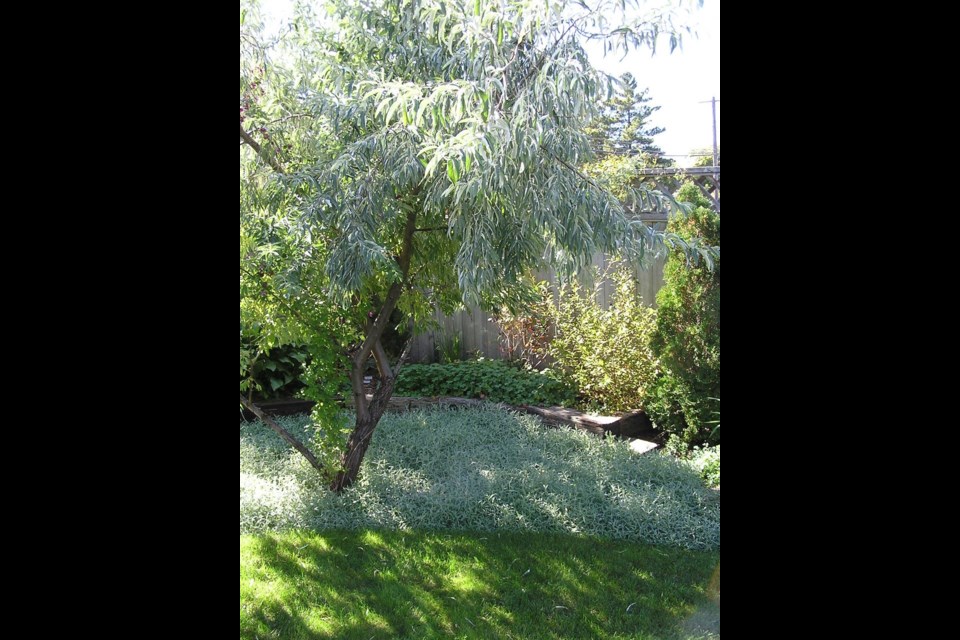Russian olive and wolf willow, both members of the genus Elaeagnus, are particularly attractive when placed next to shrubs with purple-red foliage such as many of the barberries and ninebarks, and not to forget ‘Schubert’ chokecherry as well as dogwoods in their fall red foliage. They also contrast nicely with evergreen trees and shrubs.
While Russian olive (Elaeagnus angustifolia) and your regular willow (Salix spp.) share a large and billowy “willowy” appearance, Russian olive is to dry areas what willows are to wet sites. Elaeagnus is believed to be from the Greek word for olive. The species name, angustifolia, means narrow leafed.
Native to Europe and Asia, Russian olive is a graceful, rounded, fine textured tree, ranging in height from 4.5 to 7.5 m (15–25 ft). The leaves, twigs, flowers and fruit are all covered in tiny grey scales, giving it a silvery appearance. The long, narrow leaves are retained through most of the winter, lending it an attractive “hoar-frosted” look. The inconspicuous yellow and silver flowers, borne in early June, are highly fragrant and are followed by inedible olive-like fruit (which is a source of food for birds during fall and winter). Russian olives do best in full sun on well-drained soils. They are drought-tolerant and salt tolerant but do not tolerate flooding or poor drainage. Thorny and non-thorny forms are available. These trees are useful as specimen or shade trees, in screen plantings and in shelterbelts.
Wolf willow (E. commutata; also known as silverberry) is native to the prairies and casts its sweet scent along fence lines in May, bringing nostalgic memories of walking to school to those who grew up in rural areas.
An upright and sometimes leggy shrub of up to 2.5 m (8 ft), it suckers freely, soon forming thickets. Place it with care: it can be extremely “well-behaved” for 6 or 7 years and then dozens of unwanted suckers will emerge one spring as though by magic. On farms and acreages, placement on a saline slough or a septic field is ideal. Little else will grow in these environments and it can spread freely.
The branches and leaves are covered with silvery scales. The fragrant, tubular, four-petalled flowers are inconspicuous (silver outside and yellow within) but once within sniffing distance, you’re very pleasantly aware of them. The small, silver fruit is dry and mealy.
Plant wolf willows in full sun on a variety of soils. They are saline tolerant. Wolf willow is used for wildlife plantings, naturalization, reclamation and on banks and slopes to control erosion. It provides food and cover for birds and is a nectar source for bees and other pollinators.
It is infrequently found grafted onto Russian olive rootstock (to prevent suckering), making it valuable in a shrub border, especially if planted where one can smell the fragrance in spring.
‘Silverado’ (Elaeagnus x ‘Jefsil’) is a sterile hybrid of Russian olive and wolf willow of about 3 x 3 m (10 x 10 ft) with less suckering than wolf willow.
‘Zempin’ is an improved selection, widely available in Europe but much less so here in Canada. About 3.5 to 4.5 m (12–15 ft) in height, it has very dark (almost black) branches and intense, contrasting silver foliage. It suckers freely!
Sara Williams is the author and coauthor of many books including Creating the Prairie Xeriscape, Gardening Naturally with Hugh Skinner and, with Bob Bors, the recently published Growing Fruit in Northern Gardens. She continues to give workshops on a wide range of gardening topics throughout the prairies.
This column is provided courtesy of the Saskatchewan Perennial Society (SPS; [email protected] ). Check our website (www.saskperennial.ca) or Facebook page (www.facebook.com/saskperennial) for a list of upcoming gardening events




